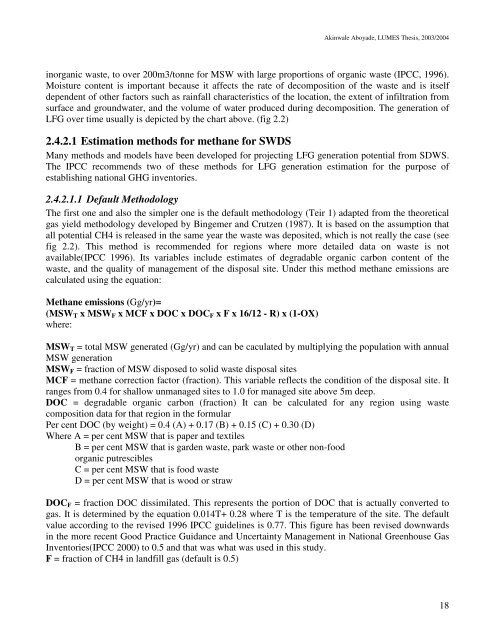Wale Aboyade's thesis - lumes
Wale Aboyade's thesis - lumes
Wale Aboyade's thesis - lumes
You also want an ePaper? Increase the reach of your titles
YUMPU automatically turns print PDFs into web optimized ePapers that Google loves.
Akinwale Aboyade, LUMES Thesis, 2003/2004<br />
inorganic waste, to over 200m3/tonne for MSW with large proportions of organic waste (IPCC, 1996).<br />
Moisture content is important because it affects the rate of decomposition of the waste and is itself<br />
dependent of other factors such as rainfall characteristics of the location, the extent of infiltration from<br />
surface and groundwater, and the volume of water produced during decomposition. The generation of<br />
LFG over time usually is depicted by the chart above. (fig 2.2)<br />
2.4.2.1 Estimation methods for methane for SWDS<br />
Many methods and models have been developed for projecting LFG generation potential from SDWS.<br />
The IPCC recommends two of these methods for LFG generation estimation for the purpose of<br />
establishing national GHG inventories.<br />
2.4.2.1.1 Default Methodology<br />
The first one and also the simpler one is the default methodology (Teir 1) adapted from the theoretical<br />
gas yield methodology developed by Bingemer and Crutzen (1987). It is based on the assumption that<br />
all potential CH4 is released in the same year the waste was deposited, which is not really the case (see<br />
fig 2.2). This method is recommended for regions where more detailed data on waste is not<br />
available(IPCC 1996). Its variables include estimates of degradable organic carbon content of the<br />
waste, and the quality of management of the disposal site. Under this method methane emissions are<br />
calculated using the equation:<br />
Methane emissions (Gg/yr)=<br />
(MSW T x MSW F x MCF x DOC x DOC F x F x 16/12 - R) x (1-OX)<br />
where:<br />
MSW T = total MSW generated (Gg/yr) and can be caculated by multiplying the population with annual<br />
MSW generation<br />
MSW F = fraction of MSW disposed to solid waste disposal sites<br />
MCF = methane correction factor (fraction). This variable reflects the condition of the disposal site. It<br />
ranges from 0.4 for shallow unmanaged sites to 1.0 for managed site above 5m deep.<br />
DOC = degradable organic carbon (fraction) It can be calculated for any region using waste<br />
composition data for that region in the formular<br />
Per cent DOC (by weight) = 0.4 (A) + 0.17 (B) + 0.15 (C) + 0.30 (D)<br />
Where A = per cent MSW that is paper and textiles<br />
B = per cent MSW that is garden waste, park waste or other non-food<br />
organic putrescibles<br />
C = per cent MSW that is food waste<br />
D = per cent MSW that is wood or straw<br />
DOC F = fraction DOC dissimilated. This represents the portion of DOC that is actually converted to<br />
gas. It is determined by the equation 0.014T+ 0.28 where T is the temperature of the site. The default<br />
value according to the revised 1996 IPCC guidelines is 0.77. This figure has been revised downwards<br />
in the more recent Good Practice Guidance and Uncertainty Management in National Greenhouse Gas<br />
Inventories(IPCC 2000) to 0.5 and that was what was used in this study.<br />
F = fraction of CH4 in landfill gas (default is 0.5)<br />
18

















